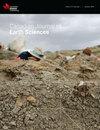ADDITIONAL ALBERTOSAURUS SARCOPHAGUS (TYRANNOSAURIDAE, ALBERTOSAURINAE) MATERIAL FROM THE DANEK BONEBED OF EDMONTON, ALBERTA, CANADA WITH EVIDENCE OF CANNIBALISM.
IF 1.6
4区 地球科学
Q3 GEOSCIENCES, MULTIDISCIPLINARY
引用次数: 0
Abstract
Albertosaurus sarcophagus specimens from the Danek Bonebed of Edmonton, Alberta, Canada were first described in 2014. Since this initial report, the University of Alberta’s annual field work has continued to yield additional tyrannosaurid material from the Danek Bonebed. In addition to nearly 200 tyrannosaurid shed teeth, five diagnostic tyrannosaurid cranial and postcranial bones have been identified to date. Three cranial bones were included in the initial description; here the newly uncovered left and right tyrannosaurid pubes (UALVP 52709 and UALVP 56262 respectively) are described and mapped in relation to the previously known material. The pubes can be confidently diagnosed as tyrannosaurid based on a posterior bow of the pubic shaft and further classified as albertosaurine by a weakly expanded obturator plate. A. sarcophagus is the only tyrannosaurid and albertosaurine known from the Horseshoe Canyon Formation, which allows for the material to be confidently assigned to this taxon. The left pubis (UALVP 52709) possesses multiple tooth traces on the medial surface that were likely made post-mortem as the medial surface of the pubis would have been deep within the body cavity of the animal and reactive (healing) bone is absent. Given the numerous large gouge-like tooth traces on the medial surface of the pubis and the abundance of cf. Albertosaurus teeth from the bonebed it seems likely that an A. sarcophagus took this opportunity to feed on a conspecific; providing evidence for the first case of cannibalism from an albertosaurine.来自加拿大艾伯塔省埃德蒙顿达内克骨床的更多阿尔伯特龙石棺(暴龙科,阿尔伯特龙属)材料,以及食人的证据。
加拿大阿尔伯塔省埃德蒙顿达内克骨床的阿尔伯特龙石棺标本于2014年首次被描述。自首次报告以来,阿尔伯塔大学的年度野外工作继续从达内克骨床获得更多的暴龙类材料。除了近200颗暴龙类脱落的牙齿外,迄今为止还确定了5块诊断性的暴龙类头盖骨和颅骨。在最初的描述中包括了三块颅骨;这里对新发现的左侧和右侧暴龙类阴毛(分别为UALVP 52709和UALVP 56262)进行了描述,并绘制了与之前已知材料的关系图。根据耻骨轴后部的弓形,可以确定这些耻骨属于暴龙类,而根据耻骨外板的微弱扩张,可以进一步将其归类为阿尔伯特龙类。石棺龙是马蹄峡谷地层中已知的唯一的暴龙类和阿伯特龙类,因此可以将该材料可靠地归入该类群。左侧耻骨(UALVP 52709)的内侧表面有多个牙齿痕迹,很可能是死后留下的,因为耻骨的内侧表面应该深藏在动物的体腔内,而且没有反应(愈合)骨。鉴于耻骨内侧表面有许多大的刨状齿痕,而且骨床上有大量的阿尔伯特龙牙齿,石棺龙很可能借此机会以同类为食,这为阿尔伯特龙的首次食人事件提供了证据。
本文章由计算机程序翻译,如有差异,请以英文原文为准。
求助全文
约1分钟内获得全文
求助全文
来源期刊

Canadian Journal of Earth Sciences
地学-地球科学综合
CiteScore
2.80
自引率
7.10%
发文量
66
审稿时长
6-12 weeks
期刊介绍:
The Canadian Journal of Earth Sciences reports current research in climate and environmental geoscience; geoarchaeology and forensic geoscience; geochronology and geochemistry; geophysics; GIS and geomatics; hydrology; mineralogy and petrology; mining and engineering geology; ore deposits and economic geology; paleontology, petroleum geology and basin analysis; physical geography and Quaternary geoscience; planetary geoscience; sedimentology and stratigraphy; soil sciences; and structural geology and tectonics. It also publishes special issues that focus on information and studies about a particular segment of earth sciences.
 求助内容:
求助内容: 应助结果提醒方式:
应助结果提醒方式:


